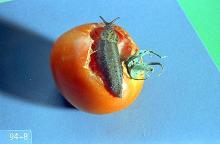Includes
Arion spp.
Black greenhouse slug (Milax gagates)
Gray field slug (Derocerus reticulatum)
Large spotted garden slug (Limax maximus)
Marsh slug (Derocerus laeve)
Reticulated slug (Prophysaon andersoni)
Pest description, crop damage and life history
See:
Common Pests of Vegetable Crops
Pest monitoring A simple but effective method for monitoring slugs is to place a handful of slug bait under pieces of scrap wood in the field after an inch or two of rain in late August or September. This also should reveal the presence of juvenile slugs. Slugs are particularly active on mild, damp evenings.
Management-cultural control
Slugs tend to be of greater concern on heavy soils, especially if the soil remains in large aggregates which provide slugs with shelter. Dense stands of weeds in field margins encourage populations to build up. Sanitation is important, as it removes food sources and hiding places. Drip irrigation lowers ambient humidity. Rotovating during periods of egg laying can reduce egg numbers.
Management-biological control
Ducks (particularly female mallards) can be confined in the planting periodically. They seek out and eat small slugs.
Management-chemical control: HOME USE
Baits are the only registered chemical controls. These must be placed where slugs will encounter them in order to be effective. Baits are required year-round in moist, irrigated areas, but are most effective if placed after fall rains in dry conditions. Rain quickly degrades baits, so reapplication will be required. Cereal-based mini-pellets perform best in the PNW.
- iron (ferric) phosphate bait-Slower activity than metaldehyde baits, and application rate is three to four times higher than that of metaldehyde. Some formulations are OMRI-listed for organic use.
- metaldehyde bait-Broadcast to seedbed around borders and between rows. Do not apply directly to plants. Use this product with caution, as it is toxic to pets.
- sodium ferric EDTA
Management-chemical control: COMMERCIAL USE
- metaldehyde baits-Do not contaminate edible plant parts. Use as needed, but not more often than once per week.



